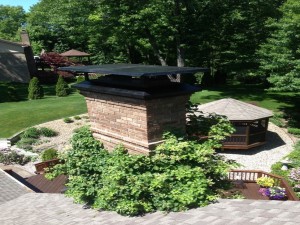 If you have more than one fireplace, you may have wondered if everything is connected to the same flue. Doctor Flue has the answer!
If you have more than one fireplace, you may have wondered if everything is connected to the same flue. Doctor Flue has the answer!
Typically, homes that are built after the 1900s have a separate flue for each fireplace; even the furnace and water heater use separate chimney flues. However, we do see some chimneys with multiple fireplaces sharing the same flue in homes dating all the way back to the Revolutionary war.
It wasn’t until the 1960s when the building code requirements officially mandated that any solid fuel-burning appliance not be allowed to share a flue with any other type of fuel. For instance, a wood-burning fireplace cannot share a flue with a gas or oil furnace. This requirement was put in place because the heat from a residential furnace exhaust can actually ignite the flammable creosote produced by wood-burning appliance or fireplace. Yikes!
In the 1970s, we saw an increase in add-on wood-burning furnaces, also called sidekicks. This is commonly done to save the cost of erecting a second chimney, but still reap the benefits of adding on an alternative fuel, such as wood, to heat the entire home.
Unfortunately, these sidekicks are often installed by homeowners going the do-it-yourself route and they unknowingly put the safety of the home and its inhabitants at risk. We still quite often see an oil fired furnace venting into a flue with the wood burner, which ignites the creosote and sparks a dangerous chimney fire.
Ultimately, your home can have multiple chimney flues or just a single flue, depending on when your home was originally constructed or your flues added-on. To be sure that your chimney flues are set up safely, contact Doctor Flue today for a chimney inspection.
Contact Doctor Flue Today!
To learn more about chimney flues or to set up an inspection of your own flue, give Doctor Flue a call at 800-438-3583 or send us an email at office@drflue.com.
Connect with Doctor Flue on social media to stay up-to-date on the latest flue news.
